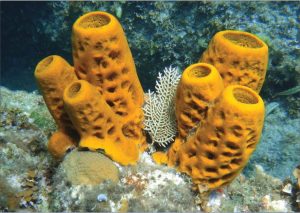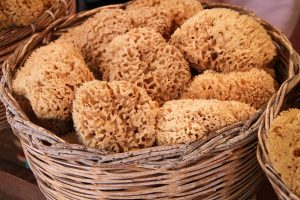The paper: Mariani, S., Baillie, C., Colosimo, G., Riesgo, A. (2019). Sponges as natural environmental DNA samplers. Current Biology. 29 (11). https://doi.org/10.1016/j.cub.2019.04.031.
DNA is everywhere – not just housed within the cells of living organisms, but sitting on the surfaces around you, flying through the air we breathe, and floating in the water we drink. As we move through life, we constantly shed our own cells into the places around us. Scratch an itch and you leave behind bits of skin cells, microscopic pieces of yourself, each containing your DNA – your own unique blueprint for life that can be used as a personal identification tool.

Just like us, other organisms shed pieces of themselves and their DNA in their own environments. If scientists collect enough of this DNA floating around in the environment (termed environmental DNA, or eDNA for short), they can determine who or what has been in a specific area. This type of information is not just useful in forensic science – trying to determine who was at the scene of a crime – but is becoming increasingly useful in different types of ecological and conservation research. Recently, scientists are finding eDNA is a powerful tool for studying rare species or when dealing with areas that are difficult to survey, like our oceans.
Collecting eDNA from the Ocean
Luckily for marine scientists, the ocean’s water acts as a vessel for floating bits of DNA shed by the marine animals they study. Since the advent of DNA analysis has enabled scientists to examine eDNA, it has been easier to determine what species are living in hard to reach habitats, trace the movements of rare animals, and non-invasively identify specimens simply by collecting water samples from an area and identifying the bits of DNA floating within it.
Okay, so there is more to analyzing eDNA than simply grabbing a glass of ocean water and throwing it on a fancy machine. As scientists refine the eDNA techniques, they are realizing the importance of having ways to collect more water (more water means more DNA and more DNA means a more accurate picture of what is living in the water) and process that water so individual species can be detected. These improvements, however, have forced scientists to turn towards more technical and expensive sampling. In an effort to find an alternative to these complicated and expensive sampling solutions, a team of scientists turned towards a simpler, biological sampling device. In fact, they decided to utilize the most simplistic animal on Earth to act as their eDNA collector: the sponge.
From bathroom scrubber to scientific sampling tool
Yes, sponges are animals. If you use a natural luffa, you are using what used to be a living, “breathing” animal to clean your body. Sponges do not technically breathe. They do, however, filter water. A lot of water. Some sponges can filter up to 10,000 liters of water a day (that is equivalent to over 2,600 gallons – enough to fill 33 bath tubs with water!). When sponges filter water, they collect microscopic floating animals (plankton) and bits of food they use for nutrients.

A group of scientist headed by Stefano Mariani from the University of Salford in Manchester, UK, realized that by naturally filtering so much water, the sponges were also filtering and collecting those little floating bits of eDNA that are pervasive in the marine environment – essentially doing the exact job that scientists had been trying to create machines to do. Mariani and his colleagues proposed that they could circumvent the expensive, high tech filtering apparatuses simply by collecting pieces of sponges and analyzing the eDNA that had been filtered and aggregated in its tissue.
The team of scientists tested their hypothesis by analyzing sponge tissue from sponges collected in two different regions (the Antarctic and the Mediterranean). When analyzing the sponge tissue, the scientists were in fact able to identify other types of animals known to live in the area, such as several different species of fish, penguins, and seals.
So can we ditch the expensive equipment yet?
This does not mean that sponges are now officially the new standard for eDNA sampling; many more follow up studies will be required to determine just how reliable data collected from sponges can be. But for now, Mariani and his colleauges have opened the door to an exciting new possibility. In many ways, sponges could work as an ideal sampling tool for scientists. Sponges are found in relative abundance throughout the oceans and could act as a sampling tool in locations where it is otherwise difficult to deploy sampling instruments. Furthermore, sponges can grow and reproduce quickly, so scientists would be able to collect pieces of sponge tissue without worrying about damaging ecosystems.
Most importantly, however, is the sheer simplicity of sponges. They cannot move. They cannot choose what to eat. They simply sit in one location, filtering whatever comes their way. Sponges are, by their very nature, unbiased filtration machines. Humans are undoubtedly capable of engineering elegant solutions to problems, but sometimes, simplicity is the most effective answer to the problem.
I received my Master’s degree from the University of Rhode Island where I studied the sensory biology of deep-sea fishes. I am fascinated by the amazing animals living in our oceans and love exploring their habitats in any way I can, whether it is by SCUBA diving in coral reefs or using a Remotely Operated Vehicle to see the deepest parts of our oceans.

